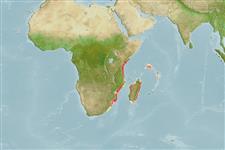>
Argentiniformes (Marine smelts) >
Microstomatidae (Pencil smelts)
Etymology: indica: Named for its type locality, Indian Ocean.
Eponymy: Fridtjof Nansen (1861–1930) was a Norwegian explorer, scientist, diplomat and later recipient of the Nobel Peace Prize. [...] (Ref. 128868), visit book page.
Environment: milieu / climate zone / depth range / distribution range
Ekologi
marina bentopelagisk; djupintervall 0 - 430 m (Ref. 41397). Deep-water
Western Indian Ocean: Mozambique.
Size / Vikt / Age
Maturity: Lm ? range ? - ? cm
Max length : 10.7 cm hane/ej könsbestämd; (Ref. 41397)
Short description
Bestämningsnycklar | Morfologi | Morfometri
Mjukstrålar i ryggfenan (totalt) : 10; Mjukstrålar i analfenan: 9; Ryggkotor: 47. Branchiostegal rays 4. Caudal peduncle length 2.0 times the depth. Anterodorsal distance is 48-52% SL. Anteanal distance is 46% SL; long head, about 21% SL. Unpigmented scale pockets; adipose fin almost completely black (Ref. 41397).
Life cycle and mating behavior
Könsmognad | Reproduktion | Lek | Ägg | Fecundity | Larver
Kobyliansky, S.G., 1992. Two new species from the genus Nansenia (Microstomatidae, Salmoniformes) from the western Indian Ocean. J. Ichthyol. 32(7):30-36. (Ref. 41397)
IUCN Red List Status (Ref. 130435: Version 2024-1)
Threat to humans
Harmless
Human uses
Verktyg
Special reports
Download XML
Internet-källor
Estimates based on models
Preferred temperature (Ref.
123201): 16.9 - 25.3, mean 19.8 °C (based on 23 cells).
Phylogenetic diversity index (Ref.
82804): PD
50 = 0.5000 [Uniqueness, from 0.5 = low to 2.0 = high].
Bayesian length-weight: a=0.00389 (0.00180 - 0.00842), b=3.12 (2.94 - 3.30), in cm total length, based on all LWR estimates for this body shape (Ref.
93245).
Trofisk nivå (Ref.
69278): 3.3 ±0.4 se; based on size and trophs of closest relatives
Fishing Vulnerability (Ref.
59153): Low vulnerability (12 of 100).
